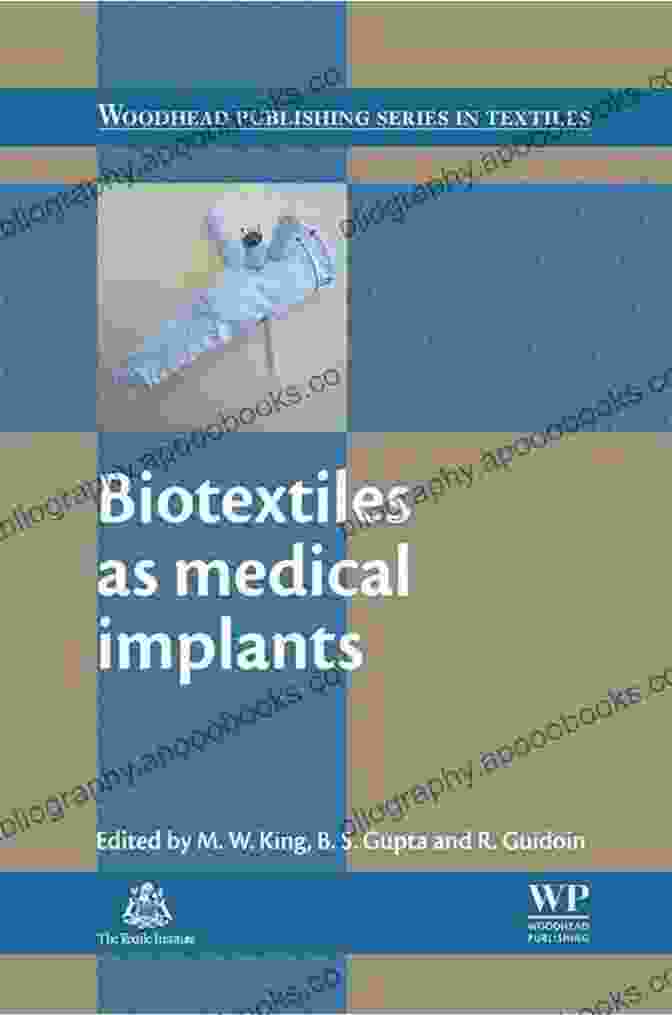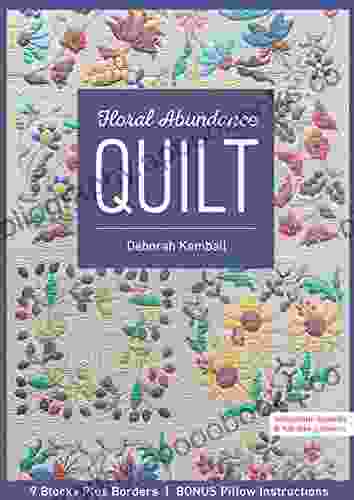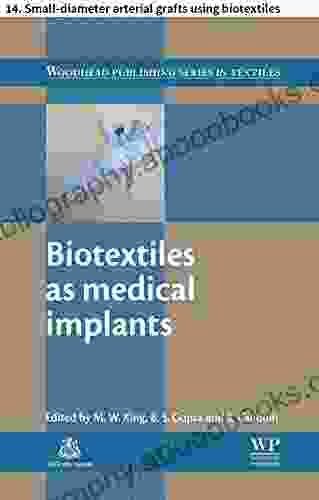Biotextiles As Medical Implants: A Revolutionary Advance In Healthcare

Biotextiles are a new class of materials that are made from living cells. They have the potential to revolutionize the field of healthcare by providing new and improved treatments for a wide range of diseases and injuries.
Biotextiles are made from a variety of materials, including natural polymers such as collagen and silk, and synthetic polymers such as polyethylene glycol. The cells that are used to create biotextiles can be either human cells or animal cells. The cells are grown in a laboratory and then processed to create a textile material.
5 out of 5
| Language | : | English |
| File size | : | 1383 KB |
| Text-to-Speech | : | Enabled |
| Screen Reader | : | Supported |
| Enhanced typesetting | : | Enabled |
| Print length | : | 47 pages |
| X-Ray for textbooks | : | Enabled |
Biotextiles have a number of advantages over traditional medical implants. They are biocompatible, which means that they are not rejected by the body. They are also biodegradable, which means that they can be broken down by the body over time. This makes them ideal for use in implants that are intended to be temporary, such as those used to repair damaged tissue.
Biotextiles are also more flexible and conformable than traditional implants. This makes them easier to implant and less likely to cause discomfort or pain. They can also be used to create implants that are tailored to the specific needs of individual patients.
Biotextiles are currently being used in a variety of medical applications, including:
- Tissue engineering: Biotextiles can be used to create scaffolds for growing new tissue. This technology has the potential to be used to treat a wide range of diseases and injuries, such as burns, spinal cord injuries, and heart disease.
- Drug delivery: Biotextiles can be used to deliver drugs to specific parts of the body. This technology has the potential to improve the efficacy and reduce the side effects of many medications.
- Medical devices: Biotextiles can be used to create a variety of medical devices, such as sensors, catheters, and stents. These devices can be more biocompatible and less invasive than traditional devices, making them more comfortable and safe for patients.
The future of biotextiles is bright. As research continues, new and innovative applications for this technology are being discovered all the time. Biotextiles have the potential to revolutionize the field of healthcare and improve the lives of millions of people around the world.
Benefits Of Biotextiles As Medical Implants
There are a number of benefits to using biotextiles as medical implants. These benefits include:
- Biocompatibility: Biotextiles are biocompatible, which means that they are not rejected by the body. This is a major advantage over traditional implants, which can often cause inflammation and other complications.
- Biodegradability: Biotextiles are biodegradable, which means that they can be broken down by the body over time. This makes them ideal for use in implants that are intended to be temporary, such as those used to repair damaged tissue.
- Flexibility and conformability: Biotextiles are more flexible and conformable than traditional implants. This makes them easier to implant and less likely to cause discomfort or pain. They can also be used to create implants that are tailored to the specific needs of individual patients.
- Versatility: Biotextiles can be used to create a wide range of medical implants, including scaffolds for tissue engineering, drug delivery devices, and medical devices. This versatility makes biotextiles a valuable tool for healthcare providers.
Future Prospects Of Biotextiles
The future of biotextiles is bright. As research continues, new and innovative applications for this technology are being discovered all the time. Some of the most promising future prospects for biotextiles include:
- Tissue engineering: Biotextiles have the potential to revolutionize the field of tissue engineering. They can be used to create scaffolds for growing new tissue, which could be used to treat a wide range of diseases and injuries. For example, biotextiles could be used to create new skin for burn victims, or new heart tissue for patients with heart disease.
- Drug delivery: Biotextiles can be used to deliver drugs to specific parts of the body. This technology has the potential to improve the efficacy and reduce the side effects of many medications. For example, biotextiles could be used to deliver chemotherapy drugs directly to tumors, or to deliver pain medication directly to the site of pain.
- Medical devices: Biotextiles can be used to create a variety of medical devices, such as sensors, catheters, and stents. These devices could be more biocompatible and less invasive than traditional devices, making them more comfortable and safe for patients. For example, biotextiles could be used to create a new type of stent that is less likely to cause blood clots.
Biotextiles have the potential to revolutionize the field of healthcare and improve the lives of millions of people around the world. As research continues, new and innovative applications for this technology are being discovered all the time. The future of biotextiles is bright.

| Application | Benefits |
|---|---|
| Tissue engineering | Biotextiles can be used to create scaffolds for growing new tissue. This technology has the potential to be used to treat a wide range of diseases and injuries, such as burns, spinal cord injuries, and heart disease. |
| Drug delivery | Biotextiles can be used to deliver drugs to specific parts of the body. This technology has the potential to improve the efficacy and reduce the side effects of many medications. |
| Medical devices | Biotextiles can be used to create a variety of medical devices, such as sensors, catheters, and stents. These devices can be more biocompatible and less invasive than traditional devices, making them more comfortable and safe for patients. |
5 out of 5
| Language | : | English |
| File size | : | 1383 KB |
| Text-to-Speech | : | Enabled |
| Screen Reader | : | Supported |
| Enhanced typesetting | : | Enabled |
| Print length | : | 47 pages |
| X-Ray for textbooks | : | Enabled |
Do you want to contribute by writing guest posts on this blog?
Please contact us and send us a resume of previous articles that you have written.
 Book
Book Novel
Novel Page
Page Chapter
Chapter Text
Text Story
Story Genre
Genre Reader
Reader Library
Library Paperback
Paperback E-book
E-book Magazine
Magazine Newspaper
Newspaper Paragraph
Paragraph Sentence
Sentence Bookmark
Bookmark Shelf
Shelf Glossary
Glossary Bibliography
Bibliography Foreword
Foreword Preface
Preface Synopsis
Synopsis Annotation
Annotation Footnote
Footnote Manuscript
Manuscript Scroll
Scroll Codex
Codex Tome
Tome Bestseller
Bestseller Classics
Classics Library card
Library card Narrative
Narrative Biography
Biography Autobiography
Autobiography Memoir
Memoir Reference
Reference Encyclopedia
Encyclopedia Patrick Bridgwater
Patrick Bridgwater David Russell Mosley
David Russell Mosley Jan Karon
Jan Karon Michael I Handel
Michael I Handel Geoff Boucher
Geoff Boucher David Tunley
David Tunley Paul Hesch
Paul Hesch Joanna Figueroa
Joanna Figueroa Maloy Krishna Dhar
Maloy Krishna Dhar Wendy Bernard
Wendy Bernard Serena Faber Nelson
Serena Faber Nelson Thomas A Adler
Thomas A Adler David Rowell
David Rowell Sean Hill
Sean Hill Naima Coster
Naima Coster Debbie Ollis
Debbie Ollis Subhasis Chaudhuri
Subhasis Chaudhuri Deborah O Hare
Deborah O Hare Jane Dobisz
Jane Dobisz John Philip
John Philip
Light bulbAdvertise smarter! Our strategic ad space ensures maximum exposure. Reserve your spot today!

 Grayson BellThe Religious Dimensions Of Popular Music: Unveil the Spiritual Tapestry of...
Grayson BellThe Religious Dimensions Of Popular Music: Unveil the Spiritual Tapestry of...
 Dillon HayesBlocks Plus Borders Bonus Pillow Instructions: Unlock Your Crochet Potential...
Dillon HayesBlocks Plus Borders Bonus Pillow Instructions: Unlock Your Crochet Potential... Edgar CoxFollow ·4.6k
Edgar CoxFollow ·4.6k Anthony BurgessFollow ·2.1k
Anthony BurgessFollow ·2.1k Jack PowellFollow ·15.2k
Jack PowellFollow ·15.2k Hugo CoxFollow ·2.1k
Hugo CoxFollow ·2.1k Fyodor DostoevskyFollow ·5.3k
Fyodor DostoevskyFollow ·5.3k Rob FosterFollow ·5.4k
Rob FosterFollow ·5.4k Adrien BlairFollow ·7.8k
Adrien BlairFollow ·7.8k Bo CoxFollow ·8.5k
Bo CoxFollow ·8.5k

 Finn Cox
Finn CoxEmpowering School-Based Professionals: A Comprehensive...
: The Role of School-Based Professionals in...

 F. Scott Fitzgerald
F. Scott FitzgeraldThe Santa Fe Trail Twentieth Century Excursion: A...
Get ready to embark on an...

 Kendall Ward
Kendall WardThe Ultimate Trivia Guide to Bruce Springsteen and the...
Bruce Springsteen...

 Jedidiah Hayes
Jedidiah HayesThe Trouble with Lacy Brown: Texas Matchmakers - A...
Prepare to be swept...
5 out of 5
| Language | : | English |
| File size | : | 1383 KB |
| Text-to-Speech | : | Enabled |
| Screen Reader | : | Supported |
| Enhanced typesetting | : | Enabled |
| Print length | : | 47 pages |
| X-Ray for textbooks | : | Enabled |










